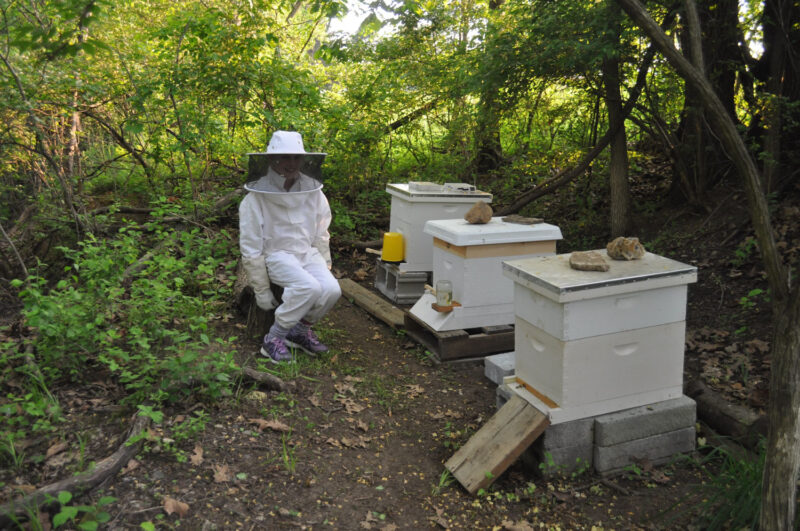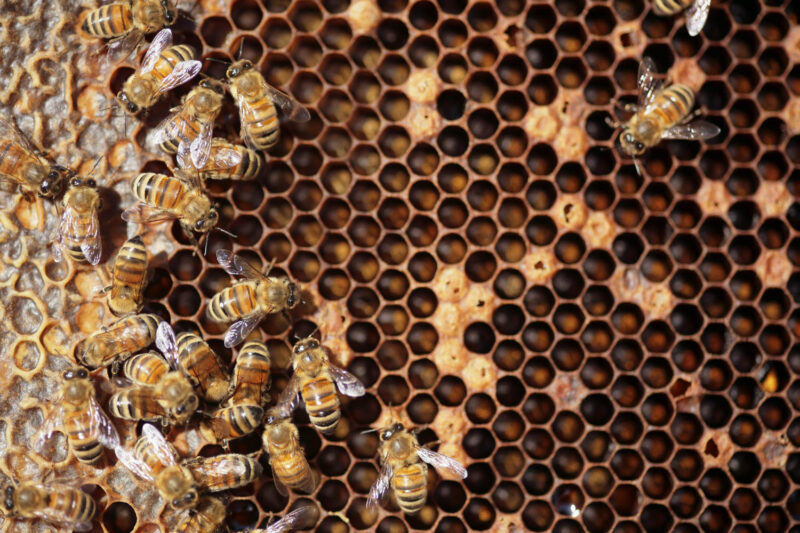
Bee happy
Show Me the Honey
I’ve spent about $4,000 on my beekeeping hobby over the years. That stings a little. But the bees need my help—and, honestly, they help me.
My queen arrived by next-day UPS along with two attendants in a tiny cage. Set me back $67. For three bugs.
But in my state of mind, that was nothing. I was desperate. I needed the honey.
And we had orders to fill. Sophia, my youngest daughter, had promised her middle-school teachers 1lb jars of our fall harvest. Tawny in color, rich, and delicious—it’s the sinsemilla of honey, if I do say so myself.
I keep three bee colonies at the edge of a stand of oak and black walnut trees across the street from my home in Pennsylvania. Once a week, I don my bee suit and walk down the path to the apiary. I love to sit on a stump and watch the foragers fly in and out of the hives like tiny jets at JFK. It’s hypnotic.
I’m often asked how many times I’ve been stung. I figure it’s at least a dozen each season. Although I wear a bee jacket with a veil and gloves for protection, invariably a few workers will sneak up underneath my jeans and sting me in the calf or ankle. It’s a hobby hazard. Although the venom really smarts, my stings are nothing compared to their struggles.

Bees have a tough life. They must contend with honey-seeking bears, skunks that love to dine on them as they fly out of their hives, viruses, and parasites like the varroa destructor and tracheal mite that suck their blood. And we humans screw with them, too, building homes in their habitats, bulldozing diverse sources of pollen and nectar.
We plant genetically modified crops and spray pesticides containing neonicotinoids that harm them and other pollinators. And then there’s global warming. It’s this cocktail of insults that some experts blame for a phenomenon called Colony Collapse Disorder.
I read about the dying bees a few years back, which triggered a desire to help. And I was hardly alone. The ranks of amateur beekeepers are growing in this country, and even city folk are getting in on the act: recently seven New York City public spaces introduced birdhouse-like “bee hotels” and planted bee-friendly flora to encourage the populations to grow.
Determined to do my part, I planted a native perennial garden in the backyard. I took Introduction to Beekeeping at a local community college. I bought a starter package of 7,000 Italian honey bees and bee suits for my three daughters. We fed our insects sugar water and protein patties until the spring dandelions bloomed.
Soon, I was obsessed. I attended meetings of the Lehigh Valley Beekeepers Association to learn bee botany from Master Beekeepers.
That’s how I knew I needed a mail-order queen, pronto.


In a single summer colony, there are about 60,000 bees. Ninety percent are workers—all female; 10 percent are male drones. There is but one queen. And my queen was dead.
Her Majesty might have succumbed to a virus, been murdered, or simply died of old age. She had been my monarch for nearly three years, the typical lifespan of an apis mellifera queen.
Worker bees live just four to six weeks in summer. Without a laying queen to replenish the colony it dwindles, as members die one by one. Key fact: female worker bees are sterile. The queen’s powerful pheromone (think Baccarat Rouge) inhibits ovary development in all her lower-ranked sisters—a sort of premeditated menopause.
When the colony recognizes that their queen has perished, they must produce another. They do it by feeding royal jelly to a handful of the remaining eggs. Enzymes in this special food turn normal bee larvae into queens. The first one to emerge from her wax cocoon will kill her rivals, go on a mating flight with drones, and begin laying up to 1,000 eggs a day.
But my bees seemed to have missed the memo. That natural process didn’t occur. So I knew I had to buy a new queen immediately to save the colony—and to ensure the supply for my daughter’s honey junkies.
A replacement queen comes packed with two worker bees in a screened wooden cage smaller than a stick of butter. Her attendants groom her during transport and feed her from a plug of fondant blocking the opening of the cage.
When the buzzing package arrived, I hurried out to the queenless hive and installed the caged insects. The queen must remain jailed for a few days to allow the 60,000 workers in the hive to memorize her pheromones and accept her. Introduce her too soon and they may think she’s an intruder, in which case: Bye, Felicia.

Three days later, her attendants had eaten through the “candy” at the cage opening, releasing the new monarch to meet her subjects and begin laying eggs. In 21 days, fuzzy-looking new bees poked their heads out of their wax cells to replace their elders at important tasks like feeding larvae, guarding the hive, and turning nectar into honey.
They also act as cleaners/funeral directors: I saw them carrying their dead sisters out of the hive. Foragers were busy bringing in nectar and bright orange sacks of pollen on their hind legs. They deposit the nectar into the wax cells and flap their wings to evaporate the water in the nectar until it’s honey-thick. Then they cap each cell in the comb with wax.
I always wait until fall to harvest because I find that the honey is darker and more flavorful than in the spring. I detect notes of butterscotch and maple syrup, possibly from the late summer nectar flow of goldenrod, aster, and buckwheat. (Spring honey reflects the dandelion and clover in the nearby fields.)
I pull and bottle about 20 lbs of honey from each colony—some to sell, most to give away at Christmastime. I must leave 60 lbs of honey in each hive for the bees to eat over the winter. My goal is to help them survive until spring, not just to show me the honey again, but to increase their numbers. It has been said that pollinators like honey bees are responsible for every third bite of food we take. “If the bee disappears from the surface of the earth, man would have not more than four years to live.”
That quote is widely attributed to Albert Einstein on the web. It’s unlikely he said that and unlikelier that it’s true. But here’s what I’m thinking:
No bees? No apples. No strawberries or melons. No coffee. No chocolate.
God Save the Queen.
Hero photo courtesy of Jeff Csatari



